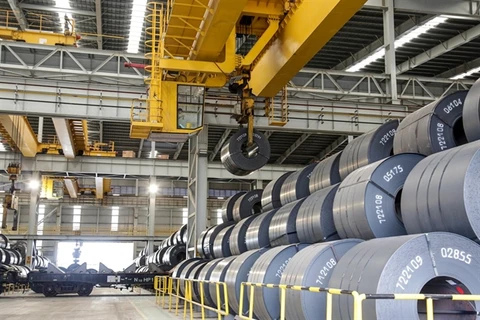HCM City (VNS/VNA) - Domestic steel demand is expected to keep falling due to the property market slump and tightened monetary policy, economic downturn in many export markets and a rise in supply making the outlook for the industry in 2023 poor, analysts said.
SSI Securities Corporation said the steel industry had a difficult 2022 with both exports and domestic sales decreasing in the second half of the year, and prices falling from the end of the year.
Businesses’ profits went down significantly as a result.
Analysts at VNDirect Securities Company said most steel companies reported dismal results.
With the property market remaining in a slump, prospects for 2023 remain gloomy, especially in the first half of the year, they said.
SSI Research said the stagnant real estate market and tightened monetary policy would drag down steel demand this year.
Citing data from the Ministry of Construction, it said the number of apartment projects licensed for construction in the first three quarters of 2022 plummeted by 41% year-on-year, and delayed projects are likely to be further delayed with developers facing liquidity problems.
It forecast domestic demand for finished steel products to decline in single digit in 2023, with the acceleration in public spending possibly making up for the reduced demand from households.
VNDirect estimated public spending to increase by 20-25% this year.
SSI Research said exports would recover slowly because of the global economic downturn.
The World Steel Association said demand is expected to recover by 1% to 1.8 billion tonnes in 2023 after falling by 2.3% in 2022.
Demand in the US and European markets is expected to decline this year as a result of the economic downturn, but the Southeast Asian market is likely to remain steady.
Vietnam’s exports to traditional trading partners could be affected by the capacity increases in recent years in neighbouring countries such as Malaysia, Indonesia and the Philippines, it warned.
So shipments of finished steel products could fall by more than 10% this year, it said.
But steel prices might be less volatile in 2023 due to steady demand in China. After falling by 2-4% in 2022, Chinese demand is expected to remain flat or rise by 1-2%, driven by the country’s reopening.
Major global manufacturers have cut their output after a long period of losses.
These factors could help regional steel prices remain steady though it is unlikely there will be strong rise since China’s reopening will also see an increase in supply.
Current prices are 20-40% higher than before the COVID-19 pandemic.
Steady prices could help steel companies stabilise profits though the weak demand would put pressure on revenues and profit margins and the price gap between Vietnam and other markets is narrowing.
SSI said profits would decline in the first half and gradually recover by the end of the year thanks to a possible demand recovery in both domestic and export markets./.
SSI Securities Corporation said the steel industry had a difficult 2022 with both exports and domestic sales decreasing in the second half of the year, and prices falling from the end of the year.
Businesses’ profits went down significantly as a result.
Analysts at VNDirect Securities Company said most steel companies reported dismal results.
With the property market remaining in a slump, prospects for 2023 remain gloomy, especially in the first half of the year, they said.
SSI Research said the stagnant real estate market and tightened monetary policy would drag down steel demand this year.
Citing data from the Ministry of Construction, it said the number of apartment projects licensed for construction in the first three quarters of 2022 plummeted by 41% year-on-year, and delayed projects are likely to be further delayed with developers facing liquidity problems.
It forecast domestic demand for finished steel products to decline in single digit in 2023, with the acceleration in public spending possibly making up for the reduced demand from households.
VNDirect estimated public spending to increase by 20-25% this year.
SSI Research said exports would recover slowly because of the global economic downturn.
The World Steel Association said demand is expected to recover by 1% to 1.8 billion tonnes in 2023 after falling by 2.3% in 2022.
Demand in the US and European markets is expected to decline this year as a result of the economic downturn, but the Southeast Asian market is likely to remain steady.
Vietnam’s exports to traditional trading partners could be affected by the capacity increases in recent years in neighbouring countries such as Malaysia, Indonesia and the Philippines, it warned.
So shipments of finished steel products could fall by more than 10% this year, it said.
But steel prices might be less volatile in 2023 due to steady demand in China. After falling by 2-4% in 2022, Chinese demand is expected to remain flat or rise by 1-2%, driven by the country’s reopening.
Major global manufacturers have cut their output after a long period of losses.
These factors could help regional steel prices remain steady though it is unlikely there will be strong rise since China’s reopening will also see an increase in supply.
Current prices are 20-40% higher than before the COVID-19 pandemic.
Steady prices could help steel companies stabilise profits though the weak demand would put pressure on revenues and profit margins and the price gap between Vietnam and other markets is narrowing.
SSI said profits would decline in the first half and gradually recover by the end of the year thanks to a possible demand recovery in both domestic and export markets./.
VNA
























